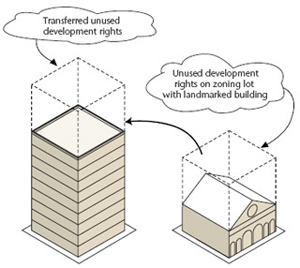Concept
Transfer of Development Rights (TDR) means making available certain amount of additional built up area in lieu of the area relinquished or surrendered by the owner of the land, so that he can use extra built up area either himself or transfer it to another in need of the extra built up area for an agreed sum of money. It is a concept of Sustainable Development.
The process of land acquisition in urban areas for public purpose especially for road widening, parks and play grounds, schools, residential and commercial buildings etc., is complicated, costly and time consuming. In order to minimize the time needed and to enable a process, which could be advantageously put into practice to acquire land for reservation purposes mentioned above.
Development Rights Certificate (DRC) means making available certain amount of additional built up area in lieu of the area relinquished or surrendered by the owner of the land, so that he can use extra built up area for him or transfer it to another in need of the extra built up area for an agreed sum of money. Which can be transferred & these transferable rights are called Transfer of development rights (TDR).
TDR was introduced in Bangalore in the year 2005 - If your property is in the way of execution of a large infrastructure project, the executing agency / the government can acquire your property by compensating you with TDR. What is actually issued to you is permission for a built-up area one and a half times the property you originally surrendered.
It is therefore a method for land protection through transferring the rights to develop from an area and giving them to another. This occurs through consensus to place conservation easements on property in agricultural areas and on the other hand allowing development densities to increase in those areas that are being developed.
Normally, costs of purchasing the easements are recovered from developers who receive building bonus. There has been increasing preservation and protection of open space, natural resources, farmland, and urban areas of historical importance all over the country as a result of this program.
This program has been used to secure land for solid waste facilities as well as golf courses. Currently, more than 20 states have amended or enacted statutes accommodating the TDR concept and 7 states have statutes specific to farmland protection.
The ownership of a property can be described as an individual’s rights. Land ownership includes rights pertaining to minerals, agriculture, timber, surface and ground water, air, and development among others. In most cases the individual development rights are constrained by the use of zoning.
TDRs concept provides for financial compensation to property owners while the society imposes the necessary land use regulations in order to control growth and development. The development right is independent of land ownership and can be shifted from one area to another.
 Transfer of Development Rights (TDRs) is a program aimed protecting our natural resources. Transfer of development rights is defined as;
Transfer of Development Rights (TDRs) is a program aimed protecting our natural resources. Transfer of development rights is defined as;
“a device by which the development potential of a site is severed from its title and made available for transfer to another location. The owner of a site within a transfer area retains property ownership, but not approval to develop. The owner of a site within a receiving area may purchase transferable development rights, allowing a receptor site to be developed at a greater density.”

Benefits of TDR:
- Having the TDR system in place it smoothens the acquisition process & gives better compensation facility.
- The TDR concept leads to better city infrastructure at a faster pace.
- Property owners who might lose a part of their land or building are compensated by the provision to build one and a half times the surrendered area on their existing property.
- The value FSI/FAR of their property in turn stands to appreciate on account of the wider roads.
- As it provides more scope of affordable housing within city limits due to the excess of built-up area on account of TDR in city limits.
- Due to TDR concept public’s money can be used for better road development.
- TDR process is a faster compensation method./li>
Examples of states where TDR prevails:
- In Karnataka, planning takes place as per the guidelines laid down in the Town and Country Planning Act. This is a State Government Act. Any amendment to this act has to come from the State Government.
- Karnataka State Government introduced section 14B in the Town and Country Planning Act in 2005 whereby if the Planning Authority or Local Authority wants to widen an existing road, form a new road, provide parks, playgrounds and open spaces or any other civic amenities, they can acquire land demarcated for these purposes from the owner for free and in exchange give the owner “development rights in the form of additional floor area, equal to one and half times the area surrendered.” The owner can either use these development rights on the remaining part of surrendered land or anywhere in the local planning areas or he may transfer the development rights to another person.
- Written by our Associate Advocate Noopur K. Dalal
+91 74348 52508
+91 79489 92182
Near Shreyas Foundation,
Manekbaug Society, Ambawadi,
Ahmedabad, Gujarat, India, PIN - 380015

